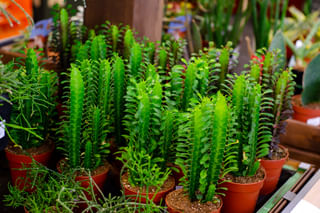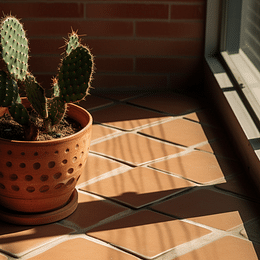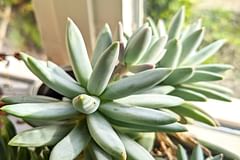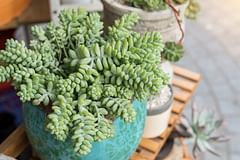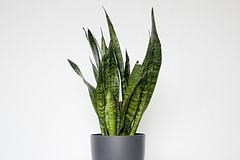How to care for an African Milk Tree (Euphorbia Trigona)
Wondering how to take care of your new African Milk Tree? This plant care guide provides easy-to-follow instructions on sunlight, watering, fertilizing, and more. Help your African Milk Tree thrive in or around your house!
Cacti and succulents are perfect plants for beginning plant owners because they're easy to take care of. One of the most difficult parts of taking care of plants, especially for beginners, is knowing how often to water their plants. It's quite easy to overwater your plants when you're just starting. This is especially true for cacti and succulents.
Are you a new plant owner wondering how to care for your African Milk Tree? Wonder no more! This plant care guide will give you all the information you need to keep your African Milk Tree healthy and happy. In addition to providing tips on water and light requirements, we'll also look at the best type of potting soil and how often you should fertilize it.
These are the topics we're going to look at together in this plant care guide:
How to water an African Milk Tree
Cacti and succulents are plants that love to be neglected and prefer it when you forget about them for weeks at a time. These types of plants thrive in warm and dry climates, which means they also don't like to get watered very often.
To water your African Milk Tree, wait until the soil is dry to the touch. Then, water your plant thoroughly, making sure that the water drains out of the bottom of the pot. A drainage hole is very important for drought-loving plants because it removes the excess moisture from the soil. This plant will not tolerate wet feet! Allow the plant to dry out completely before watering again. On average, you'll water your plant once every 2-3 weeks.
African Milk Trees are drought tolerant and can withstand long periods without water. No need to worry if you're away for a week! However, they will grow faster and produce more flowers if you water them once every week or two in the summer.
If you live in a hot and dry climate, you may need to water your African Milk Tree more frequently. So regularly check whether the soil is dry and ready for watering.
During the winter, you won't need to water your African Milk Tree as much, as plants slow down their growth. Be sure to check whether the soil of your Milk Tree is dry before you water your plant. This will generally take a little longer during the winter.
How can I prevent overwatering or underwatering my African Milk Tree?
Both new owners and experienced plant parents can find it hard to get the right balance of watering when you add a new plant to your home. To make sure your African Milk Tree thrives, it's important to water it correctly. Here's how to prevent overwatering or underwatering:
Check soil moisture
Before watering, touch the soil with your finger. It should feel dry up to an inch below the surface before you water your plant again.
Watering schedule
Water your African Milk Tree every two to three weeks, but adjust based on the plant's reaction and the humidity in your home. This is why you should always touch the soil to check if your plant is dry.
Proper drainage
Use a pot with drainage holes and well-draining soil to prevent water from collecting at the bottom.
Avoid water accumulation
Don't let the pot sit in a puddle of water. Empty the saucer under the plant pot after watering. This leftover water can cause root rot, so removing it helps your plant stay healthy.
Observe your plant
Keep an eye on the leaves. If they start to yellow or look puffy, you might be overwatering. Limp or wrinkled leaves can suggest underwatering.
Less is more
It's better to underwater than overwater. When in doubt, wait a few more days.
Remember, every home environment is different, so check your plant regularly and adjust as needed. It's okay to take time to learn what works best for your African Milk Tree!
How much sunlight does an African Milk Tree need?
Most cacti and succulents love warm and dry climates. They thrive off neglect and are true sunbathers. The same goes for the African Milk Tree!
In terms of lighting, African Milk Trees do best in bright, direct light. They can tolerate indirect sunlight as well, but this plant thrives in direct sunlight and loves to receive several hours of bright sun during the afternoon. If you live in a colder climate, keeping your African Milk Tree near a bright light source, like a west- or south-facing window is best.
Extra light in the fall and winter
Providing enough light can be difficult in autumn and winter, depending on where you live. If your African Milk Tree isn't getting enough natural sunlight, you can use a grow light to help keep it happy. You can also move your Milk Tree closer to a window, so it's exposed to a little bit more sunlight. During the summer this would be too much sunlight, but this is perfect during the autumn and winter.
What temperature range is ideal for an African Milk Tree?
To keep your African Milk Tree thriving, it's important to give it the right temperature. The African Milk Tree prefers temperatures between 16 and 27 degrees Celsius (60 to 80 F). These temperature ranges are important because if the temperatures go too high or too low, it can harm the plant.
Prevent extreme temperature changes
During the warmest months, make sure not to place your African Milk Tree in a spot where it will be exposed to intense, direct sunlight, as this can lead to overheating, even within the ideal range. Similarly, during colder months, protect the plant from dropping temperatures by keeping it away from windows that might be drafty. It is also important to avoid placing it near heaters because too much heat can dry out the plant quickly.
Humidity requirements for an African Milk Tree
The African Milk Tree grows best in environments that are like its natural habitat: a space that is not too humid, but also not too dry. When it comes to humidity, this plant is flexible but prefers a humidity level between 30% and 50%. Most houses already fall in this range, so your plant will probably feel right at home.
Checking the humidity levels
To keep an eye on the humidity levels around your African Milk Tree, consider using a straightforward tool called a hygrometer, which is designed to measure the moisture content in the air. You can find simple digital hygrometers easily online and you can place them near your plant to monitor the environment.
Raising the humidity levels
If you find that the air is too dry, especially during winter when heating systems can reduce indoor humidity, there are practical ways to raise the moisture level. Placing a shallow tray of water near your plant can help, because the evaporation will naturally increase humidity. Also, consider grouping your African Milk Tree with other plants; collective transpiration will create a more humid environment.
What is the best type of soil for an African Milk Tree?
The best type of soil for an African Milk Tree is loose, well-draining potting soil. You can find potting soil specifically designed for cacti and succulents at your local garden center. Be sure to avoid using garden soil or soil from outdoors, as these soils are often too dense and will not drain properly.
Instead of buying pre-mixed cactus/succulent soil, you can also choose to mix it yourself. The perfect mix for this consists of 3 parts of potting soil, 3 parts of coarse sand, and 2 parts of pumice or perlite. This creates a very well-draining potting soil that will drain the excess moisture to the bottom of the pot quickly while holding onto a little bit of moisture in the potting soil for your African Milk Tree.
How to fertilize an African Milk Tree
African milk trees are not heavy feeders, so you don't need to fertilize them very often. Once every two or three months is usually sufficient. When you do fertilize them, there are a few options for the type of fertilizer you can use.
The best option is to use a special cactus or succulent fertilizer. You can also use a 10-10-10 fertilizer, however, this should only be used during the growing season (the spring and summer). The best type of fertilizer that I've found is a liquid fertilizer. It's very convenient because you can add it to the water you're watering your plants with. Liquid fertilizer also helps you to control the dose of fertilizer. This prevents overfertilizing.
During the winter, don't fertilize this plant at all. The plant won't need the energy, so the fertilizer will stay behind in the pot and could cause root burn. It's best to wait until spring to fertilize again.
How often should I prune or trim my African Milk Tree?
Pruning your African Milk Tree (Euphorbia trigona) is a great way to guarantee healthy growth and keep the plant looking its best. The best time to prune this plant is during its active growing season, which falls in the spring and summer months. This timing allows the plant to recover more effectively from the pruning process and encourages strong growth.
When it comes to how often you should prune or trim your African Milk Tree, there isn't a one-size-fits-all answer as it depends on how well your plant is growing. Pruning it once per year is a safe choice, as you can help your plant look great but you're not pruning it too much and potentially causing damage.
Remember, when pruning, it's essential to use clean, sharp tools to make clean cuts and to wear gloves to protect yourself from the plant's sap, which can be irritating to the skin. After pruning, the cut areas will dry over and form a callus, which is part of the plant's natural healing process.
How to Propagate an African Milk Tree
Propagation is a great and easy way to create new plants from the African Milk Tree you already have. There are different methods you can use to do this. Below, I'll give you a simple step-by-step guide for each method, making it easy for everyone to understand.
Tools
- Gloves (to protect your hands from the sap)
- Sharp and clean pruning shears or a knife
- Potting soil
- A small pot with drainage holes
- Rooting hormone (optional)
Method 1: Stem Cuttings
Stem cuttings are a popular and straightforward way to propagate your African Milk Tree, letting you grow new plants from the ones you already love.
- Wear gloves: The sap of the African Milk Tree can be irritating, so it is important to protect your skin.
- Choose a healthy stem: Look for a stem that is green, firm, and looks strong.
- Cut the stem: Use the pruning shears or knife to cut a 5-6 inch piece from the tip of the stem.
- Dry the cutting: Place the cutting in a warm, dry spot away from direct sunlight for 1-2 days until a callus forms on the cut end.
- Prepare the pot: Fill the small pot with potting soil and water it until it is moist but not wet.
- Plant the cutting: Dip the callused end of the stem in rooting hormone, if you are using it. Push the cutting into the center of the soil, standing it upright.
- Care for the cutting: Place the pot in a warm spot with indirect light. Keep the soil moist but not soaked.
- Wait for roots: It can take several weeks for roots to form. You'll know roots have developed when the cutting starts to grow new leaves.
Method 2: Offsets
Offsets provide an easy and efficient way to propagate your African Milk Tree, yielding new plants that are genetically identical to the parent.
- Wear gloves: Always protect your hands with gloves when handling the plant.
- Find offsets: Look at the base of your African Milk Tree to find small new plants, known as offsets.
- Remove offsets: Gently pull the offsets away from the main plant. You may use a clean knife if they are hard to remove.
- Dry and plant the offsets: Like with stem cuttings, allow the offsets to callus over before planting them in moist soil.
- Care for the offsets: Provide the same care as for stem cuttings-warmth, indirect light, and regular watering without overdoing it.
Aftercare
Once your cuttings or offsets have developed roots and started to grow, you can treat them like mature African Milk Trees. Remember:
- They need bright light but can be burned by the hot afternoon sun.
- Allow the soil to dry out between watering.
- Use a well-draining soil mix.
How to transplant an African Milk Tree
When your African Milk Tree starts to outgrow its pot, it's time for a transplant. Choose a new pot that is only one size larger than the current pot. If the tree is in a pot that's too large, the roots can begin to rot. Be sure to use a cactus or succulent potting mix and make sure that the pot has drainage holes.
Gently remove the tree by grasping the base and carefully pull the Milk Tree from its pot. Depending on the size of your Milk Tree, you may need someone to help you support the plant as you place it in the new pot. Once the tree has been moved, fill it with the fresh potting mix and water well.
The best time to transplant an African Milk Tree is in the spring when it has a whole growing season ahead of it. It'll make the transition much easier and help the African Milk Tree to settle in more easily.
Steps to repot an African Milk tree
When potting your Euphorbia trigona, follow these simple steps to ensure a happy and healthy plant:
- Choose the right pot size: Select a pot that is about 2 inches larger in diameter than the current one. The African Milk Tree prefers snug spaces but needs a little room to grow.
- Provide proper drainage: The pot must have drainage holes at the bottom. This is important because the African Milk Tree does not like to sit in water. Too much water can cause root rot.
- Using suitable soil: Fill the pot with a well-draining soil mix, such as cactus or succulent potting mix. This will help keep your plant's roots dry and healthy.
- Positioning your plant: Place the African Milk Tree in the center of the new pot and fill it with soil. Pat the soil gently to secure the plant.
- Watering after potting: After potting, water the plant and place it in bright indirect light. Allow the soil to dry between waterings.
- Protect your skin: Since the sap of the African Milk Tree can cause irritation and redness, I recommend that you wear gloves whenever handling the plant.
Repotting can be quite tough if it has grown quite a bit, so it could be a good idea to ask someone to help you out with this process.
What pests and diseases can affect an African Milk Tree
As with all plants, it's important to check your African Milk Tree for pests and diseases regularly. If you notice any problems, treat them immediately.
Pests that can affect an African Milk Tree include spider mites, mealybugs, whiteflies, or scale. If you notice any of these pests on your plant, treat them immediately with a pesticide or insecticidal soap.
If you notice any of the following signs on your African Milk Tree, the tree likely has pests:
- Leaves that are wilting or browning
- Sudden loss of leaves
- Dead branches or shoots
- Honeydew deposits on leaves or branches
- Swelling or distortion of bark
- Webbing between branches
If you're unsure about the different pests that might be affecting your African Milk Tree, it's always a good idea to take a photo of the pest and show it to the employees of your local garden store. You can also share the photo on our Facebook Page to get help from other members!
Is the African Milk Tree toxic for pets?
If you are a plant enthusiast with pets at home, it's important to be aware of which plants may pose a risk to your pets. Euphorbia trigona is toxic to pets and children.
Recognizing the toxic parts of the tree
The sap of the African Milk Tree is where the danger lies. This white, milky sap contains toxins that can irritate.
When ingested or if it comes into contact with skin, the sap may result in:
- Drooling
- Vomiting
- Diarrhea
- Irritation and redness of the skin or mouth
So if you have pets or small children, you should take a few measures to make sure they stay safe. To keep your pets and children safe, consider placing the plant out of reach. If that's not an option for you, make sure to teach your pets or kids not to get close to the plant (if possible) and keep an eye on them and your plant to make sure they're being careful.
Immediate actions if ingested
Accidents happen so you should be prepared in case something goes wrong. If you suspect your pet has ingested parts of the African Milk Tree, please follow these steps:
- Do not wait: Remove any plant matter from your pet's mouth and wash the area with water.
- Contact a vet: Seek professional advice immediately.
- Provide information: Tell the vet about the plant ingestion; this will help them give the correct treatment.
When you stay alert, you can make sure your pets, children, and plants get along well and everyone involved stays safe.
How quickly does an African Milk tree grow?
If you're curious about how long it takes for your Euphorbia trigona to grow up, keep reading! I'll provide essential care tips to help your African Milk Tree thrive through each stage of its life.
On average, the African Milk Tree can take several years to reach maturity. Generally, you can expect your succulent to grow 15 to 20 cm (6 to 8 inches) every year. In ideal growing conditions, it may reach its full size, around 1.8 to 2.4 meters (6 to 8 feet), in about 10 years.
Seedling Stage (0-6 months)
- Height: Up to 15 cm (6 inches)
- Signs: Small, just sprouting, tender to the touch.
Care Tips
- Water: Keep the soil lightly moist but avoid overwatering.
- Light: Place in bright, indirect sunlight.
Young Plant Stage (6 months - 2 years)
- Height: 15-30 cm (6-12 inches)
- Signs: Begins to develop characteristic spines and branches.
Care Tips
- Water: Allow the top inch of the soil to dry out between watering.
- Light: Can handle more direct sunlight as it grows stronger.
- Potting: Repot if you see roots coming out of the drainage holes.
Adolescent Stage (2 - 5 years)
- Height: 30-90 cm (1-3 feet or 12-36 inches)
- Signs: More pronounced vertical growth and branching.
Care Tips
- Water: Water deeply but infrequently, allowing for periods of drought.
- Light: Gradually transition to more direct sunlight.
- Support: Provide a stake if the plant starts leaning.
Mature Plant Stage (5 years+)
- Height: Can reach over 1.8 meters (6 feet)
- Signs: Tall with multiple branches and a tough appearance.
Care Tips
- Water: Water only when the soil is completely dry.
- Light: Thrives in full sun or partial shade.
- Support: This may require staking to maintain an upright position if you haven't already.
- Pruning: Trim away damaged or overgrown branches.
Each African Milk Tree has its own pace, so don't worry if yours seems to be taking its sweet time. With the right care and a little patience, your plant will reach for the skies in its own time.
Staking and support
Staking Euphorbia trigona helps them grow tall and strong without risking them falling over. As we saw in the previous section on the different growth stages, you may need to begin staking your tree around the adolescent or mature plant stages. Once your African Milk Tree begins to lean or cannot stand straight on its own, it's a good idea to start staking.
Staking materials
- Bamboo stakes: Bamboo stakes are a popular choice due to their strength, durability, and natural appearance. They blend well with the plant and are sturdy enough to support its growth.
- Wooden dowels: Similar to bamboo, wooden dowels offer robust support. They can be found in various thicknesses and lengths, making it easy to choose one that suits the size of your African Milk Tree.
- Plastic rods: Sturdy plastic rods can also be used for staking. These are lightweight, won't rot over time, and are less likely to bring in pests or diseases. But they may not blend as naturally into the plant's appearance as bamboo or wood.
- Metal stakes: Metal stakes, such as those made from aluminum or steel, offer excellent strength and durability. If you choose metal, make sure it is coated or rust-resistant to prevent any potential damage to the plant or staining.
Once you've found a stake that works for you and your plant, you can add it to your plant. Be sure to choose a stake that's at least half the height of your plant, because this will offer the best support.
Place the stake as close to the main stem of your plant as possible and push it firmly into the soil. Make sure to do this quickly, as this will limit the root damage.
Once the stake is in place, gently tie the African Milk Tree to it at several points along its height. Use soft, flexible materials such as plant ties, strips of cloth, or even old nylon stockings to avoid damaging the stem. The ties should be snug enough to hold the plant upright but not so tight that they cut into the stem as it grows.
As your African Milk Tree grows, regularly check the ties to make sure they are not too tight. You may also need to add extra ties over time as the plant keeps growing.
While staking is a great way to provide the necessary support for your African Milk Tree, it's also important to deal with any underlying issues that may be causing instability, such as overwatering, insufficient light, or an overly top-heavy growth habit. You might need to prune your plant to keep it in balance.
Common signs of stress and their solutions
African Milk Trees (Euphorbia trigona) are hardy plants, but like all living things, they can show signs of stress or poor health. Here's how to spot common problems and simple ways to help your plant thrive:
Yellowing leaves
- Cause: Overwatering is often the culprit.
- Solution: Reduce watering frequency and ensure proper drainage.
Wilting or soft stems
- Cause: Root rot from excessive moisture.
- Solution: Allow the soil to dry out and consider repotting with fresh, well-draining soil.
Shriveled leaves or stems
- Cause: Underwatering may be the issue.
- Solution: Increase watering slightly, but make sure the soil is dry between waterings.
Brown Spots on leaves or stems
- Cause: Sunburn from too much direct sunlight.
- Solution: Position the plant in a bright area with indirect sunlight.
Pests like mealybugs or spider mites
- Cause: Common in dry, indoor environments.
- Solution: Wipe off pests with a damp cloth and use an appropriate insecticide if necessary.
Lack of growth
- Cause: This could be due to poor light, a nutrient deficiency, or being rootbound.
- Solution: Move to a brighter spot and consider a succulent fertilizer during growing seasons.
You can give your plant the best care if you regularly check for potential problems. Look for these signs, adjust your care accordingly, and your African Milk Tree can bounce back to health. If you need more advice, write to us or consult a local expert.
Conclusion
African Milk Trees are beautiful plants that can add a touch of the exotic to any garden. In wrapping up this guide, it's important to remember that caring for an African Milk Tree, while a unique experience, doesn't have to be a daunting task. By following the steps laid out - from potting and staking to addressing common health issues and selecting companion plants - you can create a nurturing environment for your tree. And remember, the key to a thriving African Milk Tree is as much about observing and responding to its needs as it is about the initial setup.
Regular checks for signs of stress, adjusting care routines as needed, and being mindful of the plant's environment will go a long way. We hope this guide has equipped you with the knowledge to not only maintain but also enjoy the presence of an African Milk Tree in your space.
Should you encounter any challenges, remember that help is only a question away. Share this guide with your friends and family to help them take care of their plants!
Thank you for reading this post! I hope it helps you to keep your plants healthy and beautiful! If you're looking for more guides on specific plants, you can always request a plant guide to get a guide for the plant you have trouble with.
Test your plant care knowledge
Quiz completed!
Want to learn more? Sign up for my newsletter to receive free tips in your inbox!
Sign up now!






